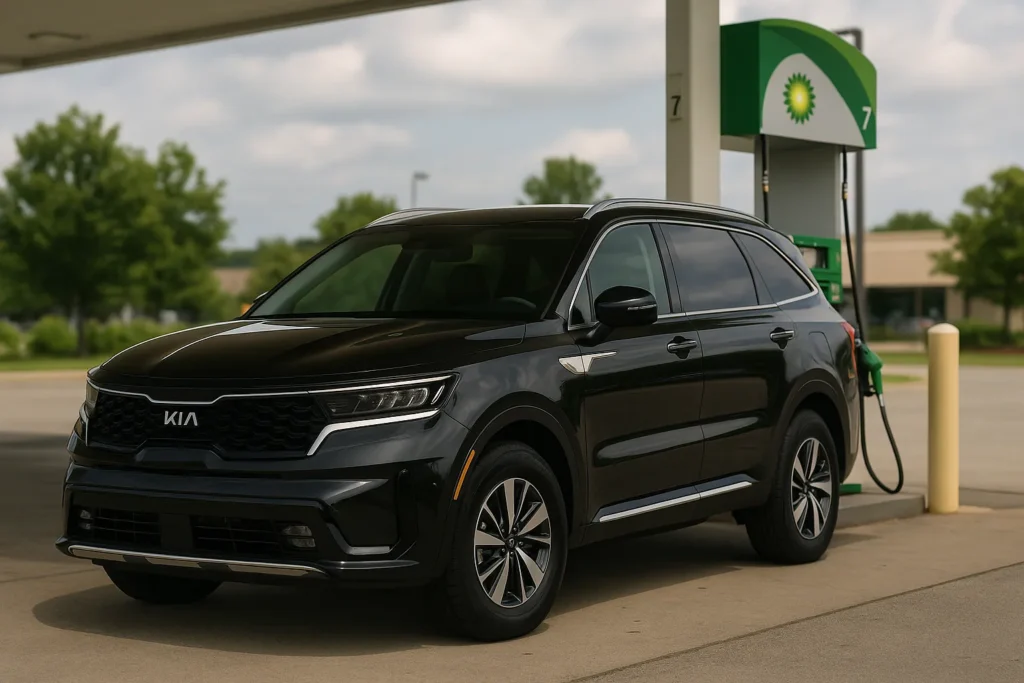If you’ve ever wondered how fuel-efficient the Kia Sorento really is, you’re not alone. The Sorento is one of Kia’s most popular midsize SUVs, known for its family-friendly comfort, stylish design, and versatile driving options. But the question most people ask before buying one is simple — how many miles per gallon does it actually get?
Here’s the thing — the answer depends on the year, engine, and type of Sorento you drive. So let’s go on a simple, honest ride through everything you need to know about Kia Sorento MPG, from real-world fuel economy to expert tips on how to squeeze more miles out of every gallon.
Snippet Definition:
Kia Sorento miles per gallon refers to the fuel efficiency of this midsize SUV, ranging from 24 MPG in gas versions to 74 MPGe in plug-in hybrids, depending on model and driving style.
Understanding Miles Per Gallon (MPG) in the Kia Sorento
MPG stands for “miles per gallon,” and it tells you how far your car can go on one gallon of fuel. The higher the number, the less you’ll spend at the gas station. Simple, right? But in real life, MPG isn’t fixed — it changes based on how and where you drive.
For example, city driving uses more fuel because of frequent stops and slow traffic. Highway driving usually gives you better MPG since the car runs smoothly at constant speeds. In the Sorento, those differences can really add up. A hybrid Sorento might give you over 37 MPG on a highway trip, while a regular gas model may hover around 25 MPG combined.
Why MPG Varies So Much
A few key things affect your Sorento’s MPG:
- Driving habits: If you accelerate hard or brake suddenly, your fuel efficiency drops fast.
- Vehicle weight: Carrying heavy cargo or roof boxes can make a big difference.
- Tires and maintenance: Underinflated tires or a dirty air filter can easily reduce MPG.
- Weather and terrain: Cold weather or uphill routes force the engine to work harder.
In other words, even two drivers with the same Sorento might see different results depending on how they treat the car.
2025 Kia Sorento MPG Ratings (Official Data)
Let’s look at the latest numbers. According to Kia and the EPA, here’s what the 2025 Sorento lineup delivers:
- Gasoline (FWD): 25 MPG combined (25 city / 29 highway)
- Gasoline (AWD): 24 MPG combined (23 city / 28 highway)
- Hybrid (FWD): 37 MPG combined (39 city / 35 highway)
- Hybrid (AWD): 36 MPG combined (36 city / 33 highway)
- Plug-in Hybrid (PHEV): 74 MPGe combined
Guess what? That PHEV number is outstanding — it combines electric and gasoline driving, giving you the best of both worlds.
The best part is that Kia’s 2025 hybrid models can easily stretch your budget further, especially if you do a lot of city driving.
How Older Kia Sorento Models Perform on MPG
If you’re considering a used Sorento, MPG still matters. Over the years, Kia has improved its engines a lot. Here’s a quick look at older model averages:
- 2023 Sorento: 24–37 MPG depending on trim
- 2022 Sorento: 24–36 MPG
- 2021 Sorento: 24–37 MPG
- 2020 Sorento: 22–29 MPG
- 2018 Sorento: 21–28 MPG
- 2016 Sorento: 20–27 MPG
- 2015 Sorento: 20–27 MPG
- 2013–2011 Sorento: Around 20–26 MPG on average
If you own or plan to buy an older model like the 2016 or 2013 Sorento, expect a modest difference in efficiency compared to the hybrids and newer 2.5L turbo engines.
Real-World MPG: What Drivers Actually See
Official numbers are one thing, but real-world driving tells the full story. Many Sorento owners share their MPG on sites like Fuelly and Reddit. For instance, drivers of the 2023 hybrid models report around 35 to 38 MPG combined — slightly lower than the EPA estimate but still impressive for a midsize SUV.
Gas models usually average between 22 and 26 MPG, especially if you spend more time in city traffic or use AWD. The plug-in hybrid (PHEV) versions get praise for letting you drive short trips on electric power alone, using almost no gas for daily commutes.
One Sorento owner mentioned that after a year of mixed driving, they still average about 36 MPG on their hybrid — proof that real efficiency doesn’t fade fast if you maintain the car properly.
Gas, Hybrid, or Plug-In Hybrid: Which Sorento Is Best for You?
Here’s the thing — Kia gives you options. The Sorento comes in multiple versions, and each one fits a different lifestyle.
- Gas models: Affordable upfront, solid power for towing or long trips. MPG is decent at 24–25 combined.
- Hybrid models: Ideal for daily drivers and families who want smooth, quiet performance with great mileage (up to 37 MPG).
- Plug-in Hybrid (PHEV): Best for city dwellers who want electric power for short drives and gasoline backup for long journeys. Delivers 74 MPGe combined when fully charged.
If you drive mostly in the city, the hybrid or PHEV will save you a lot in fuel costs over time. But if you’re more of a road-trip driver, the gas AWD option might suit you better.
FWD vs AWD: Does It Affect MPG?
Absolutely. Front-wheel drive (FWD) models are lighter and more efficient, while all-wheel drive (AWD) versions add traction but also a bit more weight. That small change usually reduces fuel economy by about one or two MPG.
So if you live in a region with mild weather and don’t need AWD, FWD might be the smarter, more fuel-efficient pick. But if you face snow, mud, or steep hills often, the slight drop in MPG is worth the extra stability.
How Many Miles Can You Get Per Gallon?
Let’s break it down in simple terms. With a Kia Sorento gas tank size of about 17.7 gallons:
- A 25-MPG model can travel roughly 440 miles per tank.
- A hybrid averaging 37 MPG can go over 650 miles per tank.
- The PHEV can easily surpass 700 miles total range when combining electric and gas power.
That means fewer fuel stops, longer road trips, and less time worrying about rising gas prices.
Practical Tips to Get Better MPG in Your Sorento
You don’t have to be a mechanic to boost your mileage. Small habits make a big difference.
- Drive smoothly: Avoid rapid acceleration and heavy braking.
- Use Eco mode: It adjusts engine response for better efficiency.
- Check tire pressure: Low tires can reduce MPG by 3–5 percent.
- Lighten the load: Empty the trunk of unnecessary stuff.
- Keep it maintained: Change oil, filters, and spark plugs regularly.
- Plan trips: Combine errands to avoid multiple short drives.
Here’s the thing — consistency is key. Even 1–2 extra MPG adds up over a year.
How the Sorento Compares to Its Rivals
When you look at the numbers, the Kia Sorento holds its ground firmly against other midsize SUVs. For example:
- Toyota Highlander Hybrid: Around 36 MPG combined
- Hyundai Santa Fe Hybrid: About 34 MPG combined
- Honda CR-V Hybrid: Around 40 MPG (smaller, less powerful)
The Sorento strikes a sweet balance — strong mileage with three-row flexibility and a refined Kia Sorento interior that still feels premium. You get a lot of SUV without sacrificing comfort or fuel savings.
Reliability and Long-Term Efficiency
Fuel economy doesn’t mean much if the car doesn’t last. Luckily, the Kia Sorento reliability record is solid. Regular maintenance, such as engine tune-ups, proper oil changes, and timely software updates, helps keep MPG steady over time.
Hybrid batteries in Kia models are designed to last well over 100,000 miles with minimal degradation. Many owners report only minor efficiency drops even after years of daily driving.
If your MPG suddenly dips, it might be time for a quick check — clogged air filters, old spark plugs, or tire misalignment can all lower fuel economy.
Environmental and Financial Benefits
Better MPG isn’t just good for your wallet — it’s great for the planet. A Sorento hybrid or PHEV produces fewer emissions, meaning you’ll lower your carbon footprint while saving hundreds of dollars each year in fuel costs.
Some states even offer rebates or tax incentives for plug-in hybrid models, making them more affordable long-term. Over five years, a hybrid Sorento can save you more than $2,000 compared to a standard gas version.
Comparison Table: Kia Sorento MPG by Model (2025 Lineup)
| Model Type | Drivetrain | City MPG | Highway MPG | Combined MPG | Approx. Range (Per Tank) |
| Gasoline | FWD | 25 | 29 | 25 | ~440 miles |
| Gasoline | AWD | 23 | 28 | 24 | ~420 miles |
| Hybrid | FWD | 39 | 35 | 37 | ~650 miles |
| Hybrid | AWD | 36 | 33 | 36 | ~630 miles |
| Plug-In Hybrid (PHEV) | AWD | — | — | 74 MPGe | ~700+ miles (with electric) |
Common Myths About Improving MPG
Let’s clear up a few things people often get wrong:
- Premium gas doesn’t improve MPG unless your car requires it.
- Idling to warm up the car wastes fuel — modern engines don’t need it.
- Fuel additives rarely make a difference.
- Over-inflating tires might boost MPG a little but reduces safety.
The truth? Good driving habits and maintenance matter way more than fancy tricks.
What’s Next for the Sorento’s Fuel Efficiency
Kia isn’t stopping here. The next generation of Sorento models will likely include more electrified options, lighter materials, and smarter hybrid systems. With Kia’s push toward full EVs like the EV9 and EV3, future Sorentos could deliver even higher MPG or full electric range.
So if you’re planning ahead, the 2026 or 2027 Sorento could be even more efficient — and cleaner to drive.
Should You Prioritize MPG When Choosing a Sorento?
That depends on your lifestyle. If you mostly drive short city routes, the hybrid or PHEV is a no-brainer — you’ll save fuel, enjoy quiet rides, and reduce emissions.
If you love road trips, tow trailers, or live in a hilly area, the gas AWD Sorento still gives great performance without draining your tank too fast.
The best part is Kia lets you pick what fits you best. There’s no one-size-fits-all answer — just solid options for every kind of driver.
Quick Tips: How to Improve Kia Sorento MPG
- Use Eco driving mode for smoother performance.
- Keep tires properly inflated.
- Avoid carrying unnecessary weight.
- Combine errands to reduce short trips.
- Get regular oil and filter changes.
FAQs
How many miles per gallon is a Kia Sorento?
The Kia Sorento’s MPG varies by model. Gas versions average 24–25 MPG combined, while hybrid models reach around 37 MPG. The plug-in hybrid (PHEV) can achieve up to 74 MPGe combined.
How many miles can a Kia Sorento go on a full tank?
With a 17.7-gallon gas tank, the Sorento can travel roughly 440 miles in gas models and more than 650 miles in hybrid versions, depending on driving habits and conditions.
What Kia gets 40 miles to the gallon?
Kia Niro Hybrid is one of Kia’s most efficient vehicles, reaching over 50 MPG combined. The Sorento Hybrid gets close, offering around 37 MPG in real-world conditions.
What SUV gets 30+ MPG with AWD?
The Kia Sorento Hybrid AWD delivers about 36 MPG combined, making it one of the most fuel-efficient three-row SUVs with all-wheel drive capability.
Is the Kia Sorento good on fuel?
Yes, it’s excellent for its size. The Sorento Hybrid and PHEV offer impressive mileage compared to other midsize SUVs, combining efficiency with family-friendly comfort and power.
What Kia gets 50 miles per gallon?
The Kia Niro Hybrid and Kia Niro Plug-in Hybrid reach or exceed 50 MPG, while the Sorento PHEV achieves 74 MPGe by combining gas and electric power.
Conclusion
So, how many miles per gallon does the Kia Sorento get? Anywhere from 24 MPG in gas models to over 74 MPGe in plug-in hybrids — depending on how you drive and what you choose.
The Kia Sorento miles per gallon story is really about balance. It’s not just about numbers on a sticker — it’s about real-world comfort, smart engineering, and value for money.
If you want a family SUV that doesn’t guzzle gas, offers three-row comfort, and gives you room to grow, the Sorento stands out as one of the best midsize choices on the market. Take it for a spin — you might just find that its fuel economy matches your lifestyle perfectly.
Disclaimer
The MPG figures and data mentioned are based on official EPA estimates, manufacturer information, and real-world owner reports. Actual results may vary depending on driving style, load, maintenance, and environmental conditions. This article is for informational purposes only and does not replace professional automotive consultation or dealership advice.

Hi, I’m Bilal, the founder of outofmagazine.com. I love sharing fresh ideas, stories, and helpful insights on all kinds of topics that spark curiosity. My goal with this site is simple—to create a space where readers can find inspiration, useful tips, and engaging reads on lifestyle, trends, and everything in between.



